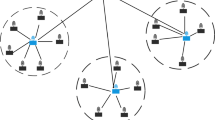Abstract
Saving energy and increasing network lifetime are significant challenges in wireless sensor networks (WSNs). In this paper, we propose a mechanism to distribute the responsibility of cluster-heads among the wireless sensor nodes in the same cluster based on the ZigBee standard, which is the latest WSN standard. ZigBee supports ad hoc on-demand vector (AODV) and cluster-tree routing protocols in its routing layer. However, none of these protocols considers the energy level of the nodes in the network establishing process or in the data routing process. The cluster-tree routing protocol supports single or multi-cluster networks. However, each single cluster in the multi-cluster network has only one node acting as a cluster head. These cluster-heads are fixed in each cluster during the network lifetime. Consequently, using these cluster-heads will cause them to die quickly, and the entire linked nodes to these cluster-heads will be disconnected from the main network. Therefore, the proposed technique to distribute the role of the cluster head among the wireless sensor nodes in the same cluster is vital to increase the lifetime of the network. Our proposed technique is better in terms of performance than the original structure of these protocols. It has increased the lifetime of the wireless sensor nodes, and increased the lifetime of the WSN by around 50% of the original network lifetime.
Similar content being viewed by others
References
I. F. Akyidiz, W. Su, Y. Sankarasubramaniam, E. Cayirci. Wireless Sensor Network: A Survey. Computer Networks, vol. 38, no. 4, pp. 393–422, 2002.
K. Römer, O. Kastin, F. Mattern. Middleware Challenges for Wireless Sensor Networks. ACM SIGMOBILE Mobile Computing and Communications Review, vol. 6, no. 4, pp. 59–61, 2002.
R. Shorey, A. Ananda, W. T. Ooi. Mobile, Wireless, and Sensor Networks, 1st Edition, IEEE press, John Wiley & Sons, 2006.
H. Eren. Wireless Sensor and Instruments Networks, Design, and Applications, Taylor & Francis, 2006.
ZigBee Alliance, ZigBee Specification, ZigBee Standard Organization, [Online], Available: http://www.zigbee.org, January 10, 2006.
S. C. Ergen. ZigBee/IEEE 802.15.4 Summary, 2004
S. Roundy, P. K. Wright, J. M. Rabaey. Energy Scavenging for Wireless Sensor Network: With Special Focus on Vibrations, Kluwer Academic Publishers, Norwell, MA, USA, 2004.
IEEE P802.15 Working Groups for WPANs, Cluster Tree Network, 2001.
V. Jolly, S. Latifi. Comprehensive Study of Routing Management in Wireless Sensor Networks — Part-2. In Proceedings of International Conference on Wireless Networks, Las Vegas, Nevada, USA, pp. 49–62, 2006.
C. E. Perkins, E. M. Royer. Ad-hoc On-demand Distance Vector Routing. Mobile Ad-hoc Networks, pp. 173–219, 2003.
H. Abusaimeh, S. H. Yang. Balancing the Power Consumption Speed in Flat and Hierarchical WSN. International Journal of Automation and computing, vol. 5, no. 4, pp. 366–375, 2008.
The Network Simulator — NS-2, Information Sciences Institute, University of Southern Californis, Marina del Rey, CA, USA, [Online], Available: http://www.isi.edu/nsnam/ns.
K. Fall, K. Varadhan. The NS Manual Formerly NS Notes and Documentation, The VINT Project, A Collaboration between Researchers at UC Berkeley, LBL, USC/ISI, and Xerox PARC, 2007.
IEEE Std 802.15.4-2003, IEEE Standard for Information Technology — Telecommunications and Information Exchange between Systems — Local and Metropolitan Area Networks — Specific Requirements — Part 15.4: Wireless Medium Access Control (MAC) and Physical Layer (PHY), Specifications for Low-rate Wireless Personal Area Networks (LR-WPANs), 2003.
Author information
Authors and Affiliations
Corresponding author
Additional information
Hesham Abusaimeh received his B. Sc. degree from Applied Science University, Amman, Jordan, in 2003, and M. Sc. degree from New York Institute of Technology in 2004, both in computer science. He is currently a Ph. D. candidate in computer science in the field of wireless sensor networks communication and routing protocols in Loughborough University, UK.
His research interests include routing protocols, network lifetime and consumption energy, computer networks, network layers communications, wireless sensor networks, and web applications security.
Shuang-Hua Yang received his B. Sc. degree in instrument and automation, M. Sc. degree in process control from Petroleum University, China, in 1983 and 1986, respectively, and his Ph.D. degree in intelligent systems from Zhejiang University, PRC, in 1991. He is a professor of networks and control. He is the director of the Networks and Control Research Group in the Computer Science Department at Loughborough University, UK. He is also an overseas professor in Central China Normal University and a guest professor in Huazhong University of Science and Technology, Petroleum University, China, and Liaoning University of Petroleum and Chemical Technology, PRC. He is a fellow of the Institute of Measurement and Control (FIMC), a senior member of IEEE (SMIEEE) and a chartered engineer (CEng) in the UK. He is an associate editor of International Journal of Systems Science and International Journal of Automation and Computing. He is also serving as a member of the editorial advisory board for International Journal of Information and Computer Security, Journal of Measurement and Control, International Journal of Advanced Mechatronic Systems, and International Journal of Process System Engineering.
His research interests include wireless sensor networks, networked control, safety critical systems, and real time software maintenance.
Rights and permissions
About this article
Cite this article
Abusaimeh, H., Yang, SH. Dynamic cluster head for lifetime efficiency in WSN. Int. J. Autom. Comput. 6, 48–54 (2009). https://doi.org/10.1007/s11633-009-0048-0
Received:
Revised:
Published:
Issue Date:
DOI: https://doi.org/10.1007/s11633-009-0048-0




